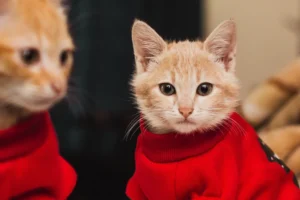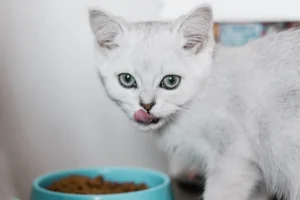Have you ever noticed how cat hair seems to cling to everything in your home? From your clothes to your furniture, cat hair has a way of sticking around no matter how much you try to remove it. But why does cat hair have this sticky quality? Let’s explore the science behind why cat hair seems to stick to everything.
Cat Hair Static Electricity
How Does Static Electricity Work?
Have you ever wondered why cat hair seems to magically stick to everything in your home? The answer lies in the fascinating world of static electricity. When your furry feline friend moves around, their hair rubs against different surfaces, creating a build-up of static charge. This charge causes the hair to be attracted to surfaces with an opposite charge, such as your furniture or clothing.
To put it simply, static electricity is the imbalance of electric charges within or on the surface of a material. This imbalance allows the material to stick to other surfaces, like cat hair sticking to your favorite sweater. So, the next time you find cat hair clinging to every corner of your home, you can blame it on static electricity at work!
Why Do Some Materials Attract Cat Hair More Than Others?
Curious why cat hair seems to have a mind of its own and sticks more to certain materials than others? It all comes down to the properties of the materials in your home. Some materials, like wool or fleece, have a rougher texture that provides more surface area for the hair to cling to. Additionally, materials that generate more static electricity, such as synthetic fabrics, are more likely to attract cat hair like a magnet.
If you find yourself constantly battling cat hair on certain items, consider opting for smoother surfaces or materials like silk or leather that are less prone to attracting cat hair. By making simple changes in your home decor, you can minimize the struggle of constantly de-furring your belongings.
Cat Hair Structure
Did you know that a cat’s hair structure plays a role in why it sticks to everything? Cat hair is uniquely designed with microscopic barbs that help the hair latch onto surfaces. These barbs make it easier for the hair to cling to fabrics and furniture, causing those pesky strands to be difficult to remove.
Next time you find yourself covered in cat hair, remember that it’s not just bad luck – it’s science at work! By understanding the principles of static electricity and the properties of different materials, you can take proactive steps to reduce the amount of cat hair that sticks to everything in your home.
What Makes Cat Hair Different from Other Types of Hair?
Cat hair is unique in its structure compared to other types of hair. The outer layer of a cat’s hair, known as the cuticle, is made up of overlapping scales that point towards the tip of the hair. This structure is what makes cat hair so prone to sticking to fabrics, furniture, and other surfaces. When a cat sheds, these tiny scales can easily latch onto materials, causing the hair to cling stubbornly.
Additionally, cat hair tends to be finer and more flexible than human hair, making it more adept at getting intertwined with fibers. This characteristic, along with the static electricity that can build up in a cat’s fur, further contributes to the stickiness of cat hair.
How Does Grooming Affect Cat Hair Stickiness?
A cat’s grooming habits play a significant role in how much hair ends up sticking to everything. Regular grooming helps to remove loose and excess hair, reducing the amount that ends up on your clothes, furniture, and floors. Brushing your cat regularly not only keeps their coat healthy but also helps to minimize shedding and the stickiness of their hair.
On the other hand, if a cat is not grooming itself adequately, this can lead to more shedding and tangling of the hair. In these cases, the loose hair is more likely to end up on various surfaces around your home, creating more of a nuisance. Encouraging good grooming habits in your cat through regular brushing and grooming sessions can help reduce the amount of hair that sticks to everything.
Environmental Factors
In addition to the unique structure of cat hair and grooming habits, environmental factors can also influence how much cat hair sticks to everything. Factors like humidity levels in your home, the type of surfaces in your living space, and even the season can all impact how clingy cat hair becomes. For example, dry air can increase static electricity, making cat hair more prone to sticking, while certain fabrics may be more conducive to trapping cat hair than others. Being mindful of these environmental factors can help you better manage and minimize the presence of cat hair on your belongings.
(External Resource: How to Clean Cat Hair from Furniture)
How Does Humidity Affect Cat Hair Stickiness?
Have you ever noticed that on muggy days, your cat’s fur seems to stick to everything like glue? Well, that’s because of the wonderful world of humidity. When the air is humid, it allows for a stronger static charge to build up on your cat’s fur. This increased static electricity makes the hair more likely to cling to various surfaces around your home.
To combat this pesky issue, consider using a dehumidifier in your home to reduce the moisture in the air. By lowering the humidity levels, you can help decrease the static charge in your cat’s fur, which in turn will reduce the amount of hair sticking to your furniture, clothes, and walls. So, keep the air dry, and say goodbye to cat hair clinginess!
Can Temperature Play a Role in Cat Hair Stickiness?
Did you know that temperature can have a significant impact on how much your cat’s hair sticks to every corner of your home? When it’s cold outside, the lack of moisture in the air can cause your cat’s fur to become more statically charged. This heightened static charge makes the hair more prone to sticking to surfaces like magic.
On the flip side, when it’s warm and humid, the moisture in the air can help neutralize the static charge in your cat’s fur, reducing its stickiness. So, if you find yourself constantly battling cat hair on your clothes and furniture during the winter months, try running a humidifier to add some moisture back into the air.
Unique Solutions
- Invest in a good quality air purifier with a built-in humidifier to maintain optimal humidity levels in your home.
- Brush your cat regularly to remove loose hair and reduce the amount of shedding throughout your living space.
- Consider using anti-static sprays on furniture and clothing to help repel cat hair and prevent it from sticking.
Remember, a little adjustment in humidity and temperature can go a long way in reducing the sticky situation of cat hair all over your home.
Tips for Reducing Cat Hair Stickiness in Your Home
Are you tired of finding cat hair on every surface in your home? Let’s tackle this furry situation head-on. First things first, frequent grooming is key. Brushing your cat regularly can help reduce shedding and prevent excess hair from floating around your home. Another tip is to invest in a good quality vacuum cleaner with a pet hair attachment. These vacuums are designed to effectively suck up those stubborn strands of cat fur that seem to cling to everything.
Furthermore, washing your cat’s bedding and your own regularly can help minimize the amount of hair being transferred around. Using a lint roller or a damp cloth to quickly pick up stray hairs on furniture and clothing can also make a big difference. Lastly, consider creating designated cat-free zones in your home where your furry friend is not allowed. This can help contain the spread of cat hair and give you a break from the constant battle against shedding.
Remember, a little effort goes a long way in keeping your home looking clean and fur-free. Keep up with these tips, and you’ll notice a significant reduction in cat hair stickiness around your living space.
Innovative Products to Help Combat Cat Hair Stickiness
Let’s explore some innovative products that can make managing cat hair in your home a breeze. One unique tool to consider is a silicone grooming mitt. These gloves are designed to attract and trap loose hair while gently massaging your cat’s coat. Not only will this help reduce shedding, but it can also strengthen your bond with your furry companion.
Another helpful product is a pet hair remover brush that works like magic on upholstery and carpets. These brushes use electrostatic bristles to lift and trap hair without the need for sticky tape or disposable sheets. If you’re looking for a more high-tech solution, consider investing in a robotic vacuum cleaner specifically designed to tackle pet hair. These smart devices can automatically clean your floors while targeting those hard-to-reach areas where cat hair loves to accumulate.
By incorporating these innovative products into your cleaning routine, you’ll be well-equipped to combat cat hair stickiness and keep your home looking pristine. Don’t let stubborn fur take over your space – take charge with these handy tools and enjoy a cleaner, hair-free environment.
Alex, a passionate animal lover, has experience in training and understanding animal behavior. As a proud pet parent to two dogs and three cats, he founded AnimalReport.net to share insights from animal experts and expand his knowledge of the animal kingdom.









